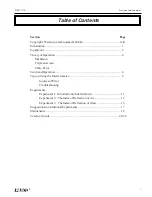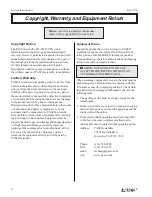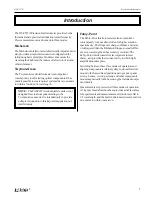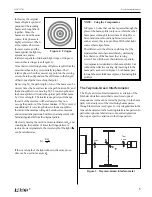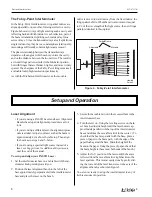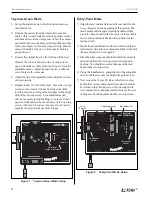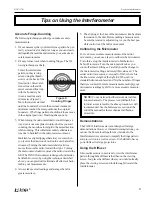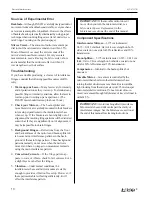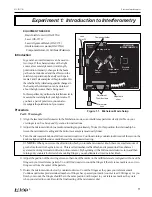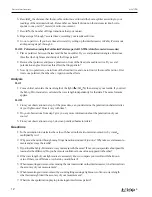
Precision Interferometer
012-07137B
10
®
Sources of Experimental Error
Backlash—
Although PASCO's carefully designed mirror
movement reduces backlash considerably, every mechani-
cal system is susceptible to backlash. However, the effects
of backlash can be practically eliminated by using proper
technique when counting fringes (see item 3 under Accu-
rate Fringe-Counting, on the previous page).
Mirror Travel—
The amount of mirror movement per
dial turn of the micrometer is constant to within 1.5%.
Most of this error occurs at the extreme ends of the
mirror’s total possible movement. For very accurate
measurements, see
Calibrating the Micrometer
, above,
and remember that the mirrors are flat to within 1/4
wavelength across their surface.
Troubleshooting
If you have trouble producing a clear set of interference
fringes, consider the following possible sources of diffi-
culty:
1.
Warm up your Laser—
Many lasers vary in intensity
and/or polarization as they warm up. To eliminate any
possible fringe or intensity variations, allow the laser to
warm up prior to setting up an experiment. (The
PASCO laser should warm up in about 1 hour.)
2.
Check your Mirrors—
The beam-splitter and
movable mirror are carefully mounted in their brackets
to remain perpendicular to the interferometer base
when set up. If the brackets are bent slightly out of
alignment, the resulting fringe patterns will be distorted
somewhat. If they are significantly out of alignment, it
may be impossible to obtain fringes.
3.
Background Fringes—
Reflections from the front
and back surfaces of the mirrors and beam-splitter of-
ten cause minor interference patterns in the back-
ground of the main fringe pattern. These background
patterns normally do not move when the mirror is
moved, and have no impact on measurements made
using the main interference pattern.
4.
Convection Currents—
If the fringe pattern ap-
pears to wave or vibrate, check for air currents. Even
a slight breeze can effect the fringes.
5.
Vibration—
Under normal conditions, the
interferometer base and mirror mounts are stable
enough to provide a vibration free setup. However, if
the experiment table is vibrating sufficiently, it will
effect the interference pattern.
IMPORTANT:
If the movable mirror doesn't
move when you turn the micrometer dial, see
Micrometer Spacer Replacement
in the
Maintenance
section at the end of this manual.
Component Specifications
Interferometer Mirrors—
3.175 cm in diameter;
0.635 + 0.012 cm thick; flat to 1/4 wavelength on both
sides; coated on one side for 80% reflectance and 20%
transmission.
Beam-Splitter—
3.175 cm in diameter; 0.635 + 0.012 cm
thick; flat to 1/4 wavelength on both sides; coated on one
side for 50% reflectance and 50% transmission.
Compensator—
Identical to the beam-splitter, but
uncoated.
Movable Mirror
— movement is controlled by the
micrometer that is built-into the interferometer base;
turning the dial clockwise moves the mirror toward the
right (looking from the micrometer side); 25 microns per
micrometer dial revolution (±1% near center of move-
ment); movement through full distance of travel is linear to
within 1.5%.
IMPORTANT:
Avoid touching all mirror surfaces.
Minute scratches and dirt can impair the clarity of
interference images. See the
Maintenance
section at
the end of this manual for cleaning instructions.


